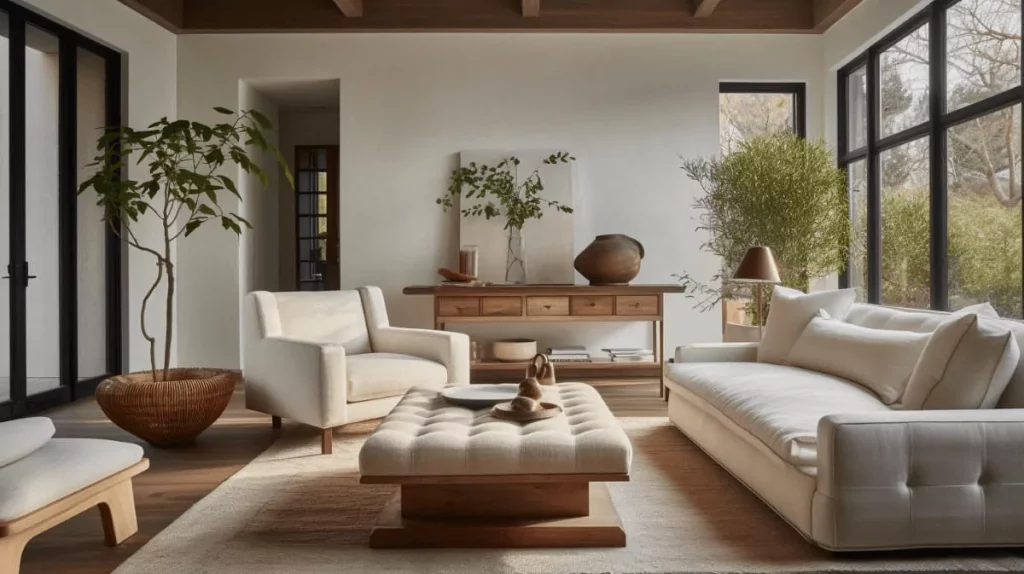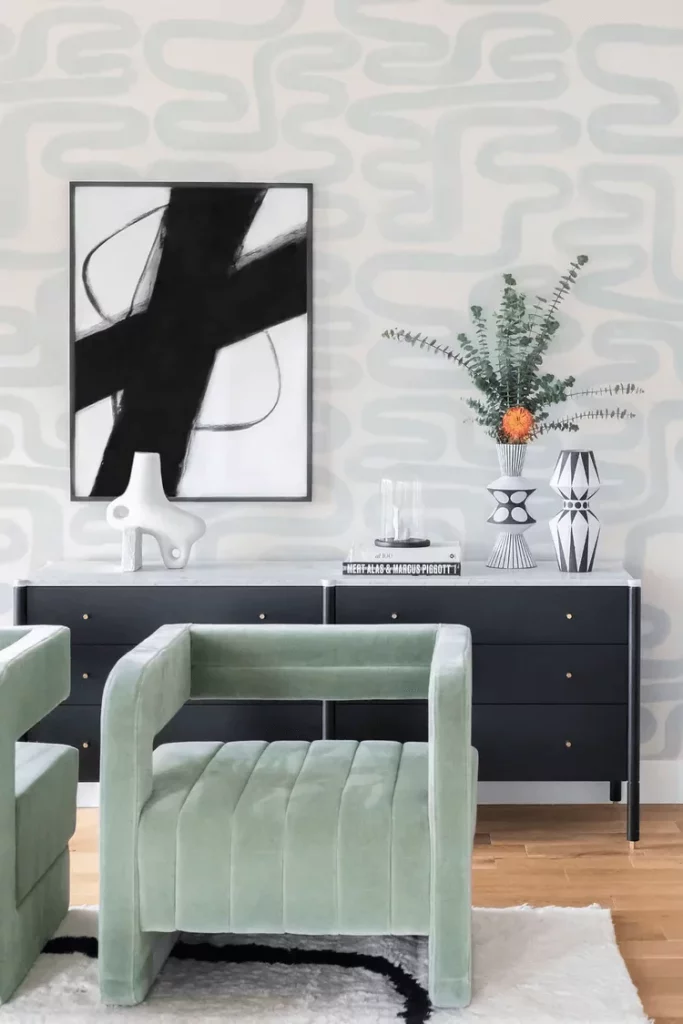
Have you ever walked into a space that felt simultaneously modern and natural, calming yet energizing? This blend of styles is the essence of organic modern interior design.
But what exactly does this popular approach entail?
In a world where concrete jungles often dominate our landscapes, organic modern interior design weaves the beauty and serenity of nature into our daily living environments. This style harmoniously marries the organic shapes, textures, and materials found in the natural world with the clean, minimalist lines that define contemporary design. By inviting the outdoors in, these spaces offer a restorative oasis – a place where beauty, tranquility, and modern sophistication coexist in perfect synergy.
The Organic Modern Journey: A Historical Perspective
The roots of organic modern design stretch back to the early 20th century Arts and Crafts movement, which emphasized handcrafted production using simple and natural forms. Architects like Frank Lloyd Wright built upon these principles, pioneering an architectural philosophy he called “organic architecture.”
Other trailblazers like Finnish architect Alvar Aalto furthered organic modern concepts through innovative use of natural materials like wood and natural lighting in designs like the Viipuri Library in the 1930s. The mid-century modern movement of the 1940s-1960s, spearheaded by designers like Charles and Ray Eames, also embraced organic curves and natural materials.
However, it was the environmental awakening of the 1960s-70s that propelled organic modern interiors into the mainstream. Architects of the “Organic Architectural” school advocated nature-inspired, eco-conscious designs minimizing environmental impact. Publications like Rem Koolhaas’ “Delirious New York” sparked discussions around integrating indoors and outdoors.
Into the late 20th century, designers like John Pawson popularized the artistic interplay of raw natural materials with minimalist aesthetics. This philosophy of biophilic, nature-nurturing spaces continues influencing contemporary designers focused on sustainability and wellbeing in our built environments.
Growing Popularity
In our fast-paced, urban existence, we often find ourselves longing for a respite – a chance to reconnect with nature. Traditionally, this meant escaping to the countryside or seeking solace in serene natural settings.
However, the rising popularity of organic modern interiors offer a masterful resolution, fluidly blending the splendor of the natural world into our dwellings, enabling us to revel in nature’s soothing caress from within the confines of our spaces.
As the concept of “green living” gains traction, encompassing not just eco-friendly practices but also a holistic lifestyle that nurtures our well-being, organic modern interiors have emerged as more than a passing trend. They represent a fusion of contemporary sophistication and nature’s timeless beauty, offering a sanctuary where we can truly unwind, recharge, and find balance amidst the demands of daily life.

How to Design a Captivating Organic Modern Interior?
While organic modern interiors share some similarities with Pared-Down Minimalist and Japandi interior designs, the emphasis lies primarily on incorporating natural materials and earthy hues into the spaces.

Color Palette: The base color scheme typically features off-white, white cream, and sandy brownish or even blackish tones, often in the form of accents. These contrasting elements subtly pop against the larger white canvas created by pieces like sofas and paintings.
Shape Selection: All the furniture, furnishings & accessories must have an organic touch. Employing curvy edges and soft geometric shapes like circles and semicircles is essential, rather than sharp, pointed edges.

Infuse Nature: The focus is on organic details, like furniture and accessories made from materials found in nature, in their least altered form. This can include unpolished stone vases, driftwood that has never been stained, and raw linen fabric over polyester blends.

Illumination: Incorporating large windows with simple geometric shapes and basic curves enables the abundant flow of natural light into the built environment. Artificial lighting can take an organic form, with lamps and fixtures crafted from materials like wood, rattan, or clay that blend with the overall aesthetic.


Grounded Elements: In addition to the subtle white walls, the choice of monolithic and grounded furniture becomes imperative in this style. Sofas and dining tables typically have small or no tall legs. Light materials like cotton, linen, and natural fabrics in very light colors are suggested for sofas throughout the home. Meanwhile, the dining table can provide a subtle contrast, made of marble or lighter textured wood tones.

Intermediate pieces like armchairs and coffee tables can complement the larger elements. Coffee tables are often made of natural materials but more polished and rounded, never laminated. An armchair in a darker wood with an upholstered look in boucle fabric can make the interior more inviting and cozy. Smaller elements like side tables and dining chairs can punctuate and stand against the larger pieces like sofas and dining tables.

For furniture with the right colors, materials, and shapes that effortlessly coalesce with the organic modern style, Japandi-inspired minimalist furniture can be an excellent option, particularly for storage or showcase pieces.
Taking over the Commercial Sector
The fusion of Modern and Organic design isn’t limited to residences alone; it’s rapidly becoming the preferred choice for Next-Gen Offices, Co-working Spaces, Cafes, and Restaurants. This aesthetic is being embraced by both multinational corporations and startups, aiming to foster an engaging and nourishing work environment for their employees.


Practicing Organic Modern on the Ground
- Wabi-Sabi by Anthology Creative Studio (Outremont, Québec)This renowned Interior Decor Studio breathed life into a previously uninspired space through the Organic Modern style and transformed it into a forever home.

Wabi-Sabi | Anthology Interiors White walls with simple plaster moldings, natural material & neutral-earthy color tone of furniture, monolithic design of elements, and organic shapes of accessories, all come together to give the space an Organic Modern look.

Wabi-Sabi | Anthology Interiors - Flintstone6 House by Mitti Eco-friendly Constructions (Tamil Nadu, India)A sustainable model house constructed in a village on the outskirts of Tamil Nadu adopted a few elements of Organic Modern Style in the Indian context.
COVID-19 posed a limitation on the availability of raw materials, which became a perfect opportunity for designers to incorporate raw materials like soil and stone for making walls & large pieces of grounded furniture bases like kitchen counter, sofa & dining table.

FlintStone6 | Arch Daily Contrasting furniture made of natural materials like cane & jute complies with the neutral tone of the style. Large openings of glass enable a smooth transition from natural to built.

FlintStone6 | Arch Daily
Additional Tips for Decorating With Organic Modern Design
- Lean into light tones of wood rather than darker ones, for prominent pieces of furniture
- Introduce pops of color through accent pieces like throw pillows, rugs, or artwork inspired by nature.
- Arrange plants of various shapes, sizes, and textures to establish a dynamic botanical environment within your living space.
- Experiment with layering different textures and materials to add depth and dimension to your space.
- Integrate natural aromatherapy elements like essential oil diffusers or scented candles to enhance ambiance.
- Blur the line between natural & built by treating spaces with large windows


Nature has always been the greatest artist, and organic modern interior design is a celebration of her masterpieces. It’s a design choice that offers a respite from the hustle and bustle of modern life, crafting environments that are both visually pleasing and profoundly comforting. With an emphasis on balance of natural and man-made worlds, organic modern design is a fixture, revitalizing our indoor spaces with a sense of renewal.
As design trends continue to evolve, the emphasis on sustainability, biophilia, and minimalism suggests a promising future for this style, offering environmental consciousness for generations to come.
References
- https://hommes.studio/journal/what-is-modern-organic-interior-design/
- https://medium.com/@mindfuldecors/embracing-nature-exploring-the-allure-of-organic-modern-interior-design-a427e2cbb6c6
- https://www.houzz.in/magazine/how-to-bring-the-organic-modern-style-into-your-home-stsetivw-vs~114959656
- https://www.dezeen.com/2022/08/07/ten-interiors-organic-modern-design-lookbooks/
- https://www.autonomous.ai/ourblog/7-key-features-of-organic-modern-interior-style
- https://basq.livelarq.com/design/what-is-japandi-interior-design/
- https://www.archdaily.com/990119/flintstone6-house-mitti
- https://www.desiretoinspire.net/2021/02/18/anthology-creative-studio/
- https://www.archdaily.com/982222/interior-design-aesthetics-22-projects-that-explore-trending-interior-styles
- https://www.studiojeandre.com/post/organic-modern-home
